TENTH INTERNATIONAL
ORGAN AND EARLY MUSIC FESTIVAL
OAXACA, MEXICO
PRESENTATION OF THE NEWLY RESTORED ORGAN
IN
SANTA MARÍA DE LA ASUNCIÓN TLACOLULA
FEBRUARY 20 - 25, 2014
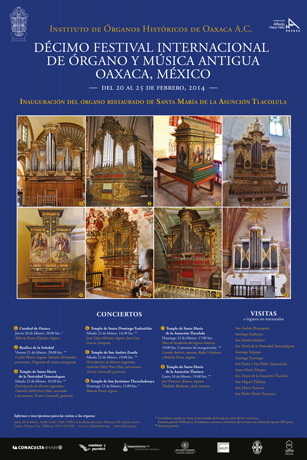
Over one hundred people from six foreign countries and six different states of Mexico gathered in Oaxaca during the glorious month of February to revel in the IOHIO’s tenth celebration of the Oaxacan organs.
The festival activities extended over six and a half days and included:
• concerts on eight restored Oaxacan organs
• visits to twelve unrestored organs with explanations of their church art and history
• guided tours of the archeological sites of San Martin Huamelulpan and Santa María Atzompa
• the presentation of a series of postage stamps depicting Oaxacan organs
• an exhibit of manuscripts from local archives “Oaxacan Organs and their Builders”
• the opportunity for organists to play several Oaxacan organs
• a mass and concert to bless and reinaugurate the recently restored organ in Santa María de la Asunción Tlacolula
• delicious local cuisine, band music and dancing in several communities.
Fortunately the theme of historic pipe organs is increasingly familiar in those towns which still have instruments, and it’s remarkable that slowly but surely the idea of an organ, its sound and its conservation, has begun to penetrate public awareness. We were consistently received by the authorities with respect and often ceremony, the choir lofts and churches had been cleaned beforehand, and the local people were most appreciative of our attention to this previously unknown part of their cultural heritage.
February 20 (Thursday)
The Festival began with the Inauguration of the Festival and reception in the Oaxaca Philatelic Museum (MUFI). Cicely Winter, director of the IOHIO, spoke about the activities and goals of the festival and was followed by María Isabel Grañen Porrúa, president of the Fundación Alfredo Harp Helú Oaxaca, Sergio Bautista Orzuna, director of the Oaxaca Regional Center of the Instituto Nacional de Antropología e Historia (INAH) and Emilio de Leo, in representation of the Secretaría de Cultura y las Artes of the Oaxaca state government. All of them offered words of congratulations and the support of their respective institutions.

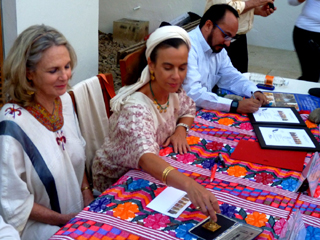
The IOHIO office has always been housed in the MUFI and during this festival our two institutions were able to present a tangible product of our 14-year collaboration: a series of postage stamps depicting six Oaxacan organs and a special postal cancellation in honor of the Tenth Festival.

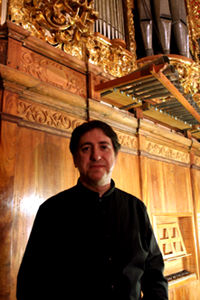
After a welcoming reception, everyone proceeded to the Oaxaca Cathedral for the First Concert of the Festival, offered by the renowned Spanish organist Roberto Fresco, titular organist of the Almudena Cathedral in Madrid (program). A long line wound out into the atrium to purchase tickets and attendance surpassed 350 people . Roberto’s elegant performance transfixed the audience and it was certainly one of the most beautiful concerts ever heard on this organ.
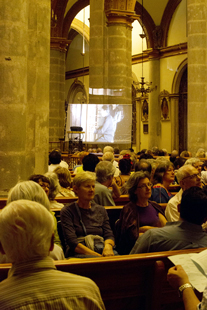
Because of the position of the organ in the choir loft, the organist’s back is to the audience, so this and all succeeding concerts were projected onto a screen in the church. In this way the audience could appreciate the changing of registers and watch Roberto’s hands as he played.
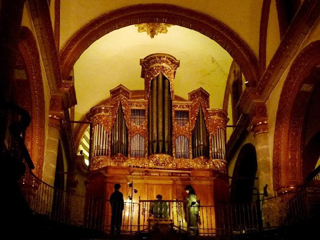
This monumental 8' organ was built in 1712 and retains its opulently carved and gilded upper case, but its lower case has been rebuilt several times and there is no evidence of its original appearance. However, one can assume that it was once one of the most lavishly decorated organs in Oaxaca, based on the contract for its construction.
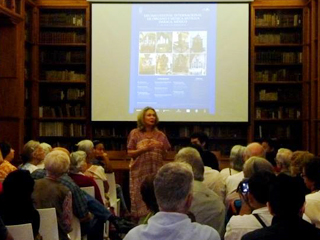
February 21 (Friday)
The day started with a bilingual presentation by Cicely Winter in the Francisco de Burgoa Library within the Santo Domingo Cultural Center about “The Historic Organs of Oaxaca and the Work of the IOHIO”. Although the title of the talk has not changed over the years, the content always does, and the images of the organs and the various IOHIO projects - protection, conservation, restoration, presentation of concerts, discoveries related to the organs, recordings and publications - spoke for themselves.
This was followed by an exhibit of documents, “Los Órganos Oaxaqueños y sus Artífices” (“The Oaxacan Organs and their Builders”), inaugurated by María Isabel Grañen Porrúa, the director of the Library, and explained by the curator, former IOHIO collaborator Ricardo Rodys, as well as the presentation of a book with the same title edited by Rodys and Lérida Moya Marcos. The theme was chosen to honor the recent restoration of the Tlacolula organ and featured organ contracts and references to builders from local archives.


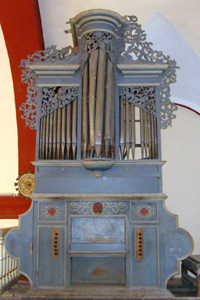
We then climbed into the vans that would become so familiar to us during the days ahead for the field trip to visit three unrestored organs in the Tlacolula Valley. The first stop was in San Matías Jalatlaco, located on the edge of the historic center of Oaxaca City.
We ascended the first of the many winding stone staircases we would face during the days ahead to admire the elegantly proportioned blue 8´ (foot) organ, built in 1866 by the distinguished Oaxacan organbuilder Pedro Nibra.
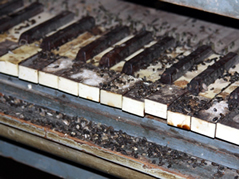
The choir loft looked neat and clean, but once we removed the keyboard cover, lo and behold, mice had invaded and left their droppings all over the keyboard! Actually it allowed participants to see the ongoing challenge of organ conservation, since only a year had passed since our last visit to this church.
Though missing around 30% of its pipes, the Jalatlaco organ is still an excellent candidate for a future restoration. When the vans were ready to leave, three participants were missing and it turned out they had been locked in the choir loft, shouting for help, after the sacristan thought everyone had already come down!
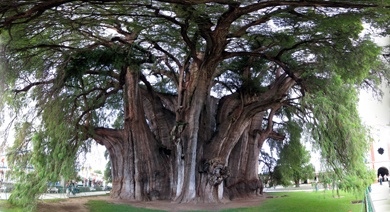
We made a quick stop at the famous Tule tree and a local guide pointed out the images evoked by the gnarls of the trunk and branches. Around 1500 years old, this Montezuma cypress (sabino or ahuehuete) has the stoutest trunk in the world.
Our next destination was San Miguel Tlalixtac, included for the first time in our festival tour. One of the later and larger organs of the Oaxacan school (built ca. 1860), it must have had an impressive look and a huge sound. Many components are missing and a complete reconstruction, though theoretically possible, would make little sense at this point. But for the time being the IOHIO assures its conservation and it was heartening to see our labels still in place from the previous visit some years back. The challenge posed to participants was to imagine how the organ might have looked, based on what remains.
 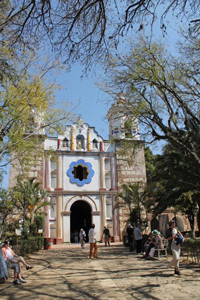

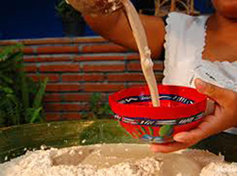
We were received in San Andrés Huayapam located on the outskirts of Oaxaca City, with a drink of tejate, traditionally served in colorful painted half gourds. A local specialty of prehispanic origin, this delicious foamy drink is made with ground cacao, corn meal, the seed of the mamey fruit and the flower of a tree (rosita de cacao) which grows only in and near Huayapam.
This lovely village church has one of the most beautiful altarpieces in Oaxaca, whose intricately carved columns are referred to as “gilded lace”. Also famous is the collection of antique exvotos, petitions usually to the Virgin Mary that are painted on small tin plaques. This and succeeding visits were enhanced by commentaries about the church art by specialists Richard Perry (http://colonialmexico.blogspot.com/) and Montserrat Galí.
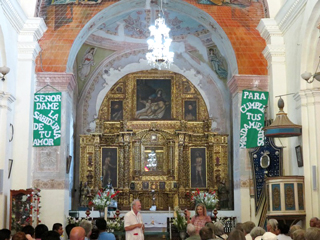 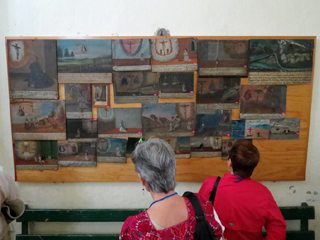
The 4´ table organ (1772), simply carved and originally painted bright red but now a dark maroon color, is nearly intact and like Jalatlaco, an excellent candidate for a future restoration.
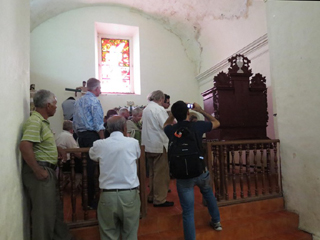 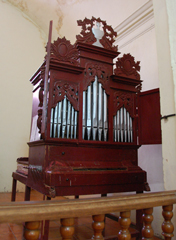

In Huayapam we savored the first of many exquisite meals prepared by the local women.. We had mole amarillo served in the atrium of the church.
That night organist Cicely Winter and percussionist Valentín Hernández presented the Second Concert of the Festival in the Basílica de la Soledad featuring well-known regional folk music (program). Joel Vásquez and Andrea Castellanos were indispensible in pulling the stops, since the music required many changes of registration. The church was once again packed with more than 350 people and the audience had a chance to sing along to several pieces from the texts provided in the programs. The magnificent decorated case of this monumental 8´ organ bears the earliest date of any Oaxacan organ: 1686. The interior components were rebuilt during the 18th century, and the organ was restored in 2000.
 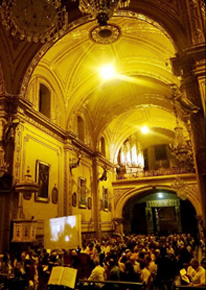
February 22 (Saturday)
The all-day field trip to the Mixteca Alta began with the Third Concert of the Festival in Santa María de la Natividad Tamazulapan and featured professional Mexican and foreign organists signed up for the Festival who were delighted to have a chance to play the Oaxacan organs. The contrasting pieces selected by Warren Steel, Margarita Ricardez, Víctor Manuel Rodriguez, and Mary Jane Ballou showcased this little 2´ organ to best advantage.
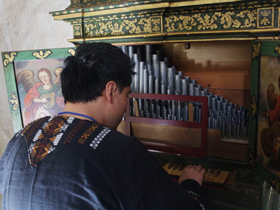 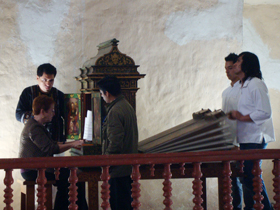
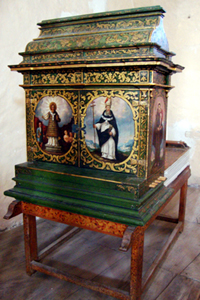
The 2´ portative organ dating from approximately 1720-1730 is situated in a high side balcony overlooking the huge nave of the church and is exquisitely decorated with images of saints and angel musicians. The case and bellows are original but the pipes, keyboard and interior components were reconstructed in 1996.
As in years past, we have featured music on other instruments to alternate with this small organ and enjoyed the contrast of its sound with baroque and contemporary marimba pieces played by Oaxacan percussionist Gabriela Edith Pérez Díaz and the three guitarists of the ensemble “Terceto Cuicacalli” (Mexico City): Diego Arias Ángel, Miguel Ángel Vences Guerrero, and Eduardo Rodríguez de la Torre (program). The church has one of the most magnificent baroque altarpieces in all Mexico and includes paintings by the renowned 16th century Spanish painter Andrés de Concha.
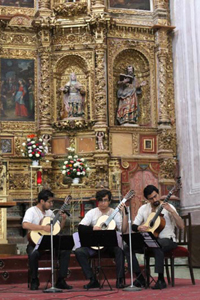
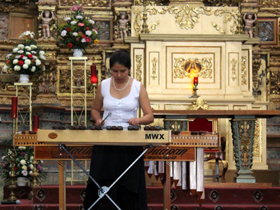
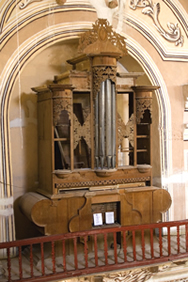
The second organ in this church, an 8´ instrument built in Oaxaca in 1840, faces the small organ from the left balcony. Once a magnificent instrument, it has unfortunately been the victim of vandalism over the years and is missing most of its pipes. Its neo-classic, undecorated aspect contrasts with the baroque opulence of the portative organ.
Our next stop was in the neighboring town of Santiago Teotongo, in which the baroque altarpieces and organ all appear to date from the 18th century, offer a pleasing consistency of artistic style. The profile of the 8´ organ closely resembles that of San Mateo Yucucuí (1743), thus giving us a clue as to its more specific date of construction. Even though it lost all its pipes and keyboard during the Mexican Revolution, the magnificent gilded and painted case still exists.
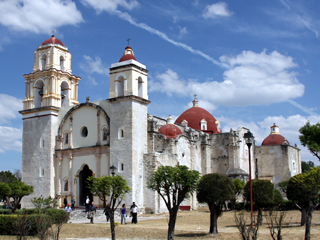 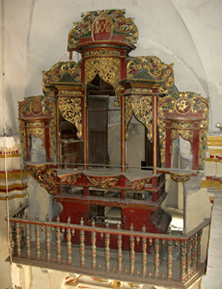

The Fourth Concert of the Festival took place in Santo Domingo Yanhuitlán, the 16th century Dominican base in the Mixteca Alta. With its soaring stone vault supported on the sides by flying buttresses and its magnificent altarpieces, it is one of the Mexico's most dazzling complexes of baroque art.
Organist Jesús López Moreno (titular organist of the Mexican City Cathedral), and trumpet player Juan Luis González offered a thrilling program which reverberated throughout the immense atrium . Located on a decorated lateral balcony, the 8´ organ was built around 1690-1700 and reconstructed in France in 1998. Its case is one of the most elaborately decorated in all of Oaxaca with fantastic swirling imagery as well as Dominican symbols on the case and fierce faces painted on the façade pipes.
 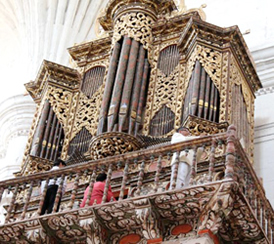
Thanks to the ongoing support of the Federal Road and Bridge Commission, a special entrance was opened from the super highway, allowing us direct access to San Andrés Zautla and saving us over an hour of travel time. The folk fiesta and friendly concert in Zautla, contrasting with the majesty of the preceding visit to Yanhuitlán, are always a highlight of the Festival.
We were received in the atrium of the church by the elderly women of the town, dressed in their traditional skirts and blouses, the local band with fireworks, plenty of mezcal, necklaces of bugambilia, and dancing.
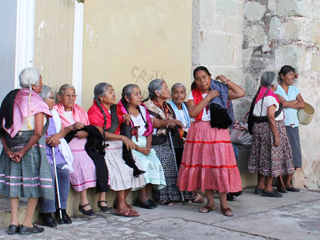 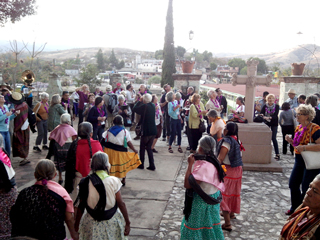
And after all of this, a delicious meal of estofado de pollo (chicken stewed in almond sauce) served in the patio behind the church.
 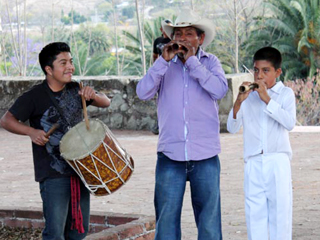
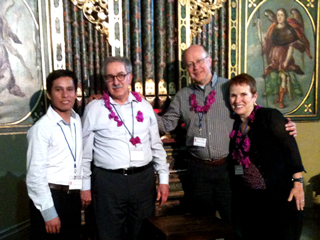
After dinner, we crowded into the lovely little church to hear the Fifth Concert of the Festival, presented by organists Mary Jane Ballou, David Furniss, Lee Lovallo and Tonatiuh González, in alternation with Gabriela Edith Pérez Díaz, percussion, and the guitarists of the Terceto Cuicacalli. Once again the organists presented wonderfully contrasting pieces, even without knowing how they would fit in with the rest of the program. There is always a nice improvisatory feel to this concert, particularly at the end of such a packed and exciting day.
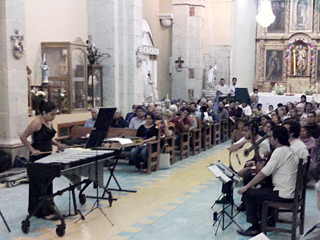
It ended with a stirring rendition for vibraphone and guitars of the famous “Huapango” of José Pablo Moncayo.
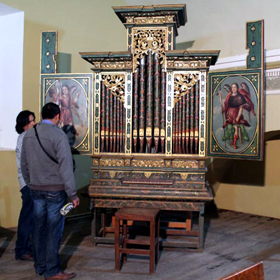
The case of this 4´ table organ (1726) is exquisitely gilded and painted with images of Saints Peter and Andrew and four archangels. The Zautla and Tamazulapan bellows are still hand pumped and the register sliders are on the sides, and the projection on the screen allowed people to appreciate the teamwork involved.
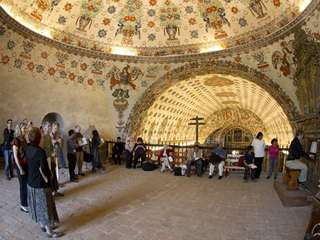
February 23 (Sunday)
This year we arranged time for interested artists and students to play the organs in Tlacochahuaya and Tlaxiaco and 20 organists, about half foreign and half Mexican, took advantage of the opportunity. There was a delightful atmosphere of camaraderie and we all got to hear many new pieces on yet another organ.
The rest of the group joined us before the Sixth Concert of the Festival in San Jerónimo Tlacochahuaya, played by Roberto Fresco (program). His expert touch lured subtleties of sound out of the organ rarely heard.
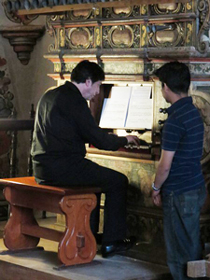 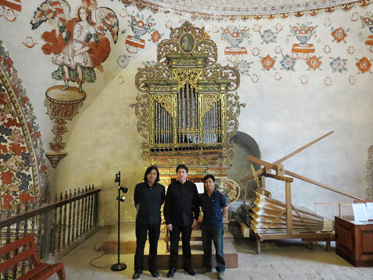
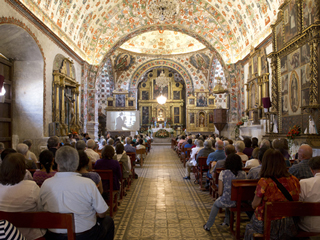
This church is one of the loveliest in Mexico with its exuberant interior floral decoration and exquisite baroque altarpieces, all recently restored. The organ was built sometime before 1735 and restored in 1991. The case and pipes are exquisitely decorated with floral motifs, and the organ harmonizes beautifully, both visually and acoustically, with the architecture of the church.
We savored a variety of Oaxacan specialties in the “Donají” Restaurant in Mitla before proceeding to Tlacolula where we would spend the rest of the day.
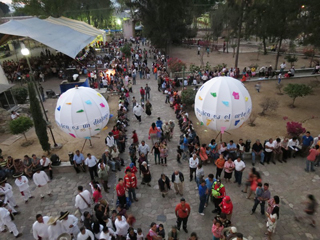
The atrium and church were already bustling with people when we arrived in anticipation of the mass and reinaugural concert of the 8' organ, built in Oaxaca in 1792 by Manuel Neri y Carmona for the community of Santa María de la Asunción Tlacolula.
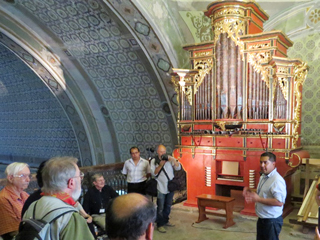
Interested participants could climb up to the choir loft to see the newly restored organ up close, hear about its restoration (the case by Oaxacan restorer Eric González Castellanos and the musical and mechanical aspects by the Gerhard Grenzing Taller, El Papiol, Spain) and admire its gorgeous red, gold and black case decoration. This organ also has the most elaborately painted façade pipes in all of Mexico.
Afterward organ aficionados could see the unrestored positive organ, built around 1700 and the smallest in Oaxaca with just two ranks. It was built specifically for the recently restored baroque side chapel of the Señor de Tlacolula. Those who needed a break from organs were able to enjoy one of the most famous indigenous markets in Oaxaca and admire the women’s costumes and the stalls piled high with local produce.
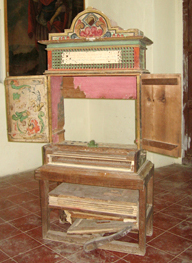 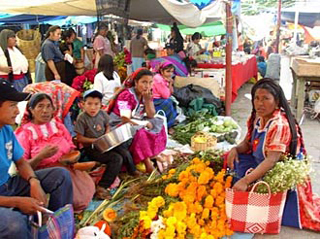
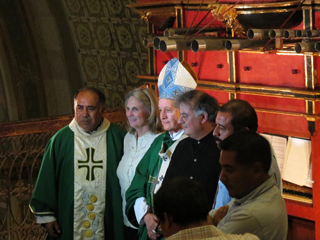
At last the long-awaited moment arrived for the blessing of the organ in a special mass by Monseñor José Luis Chávez Botello, Archbishop of Antequera Oaxaca. The mass was enhanced with participation of the Oaxaca City Chorus, Lourdes Ambriz, soprano, and Rafael Cárdenas and Cicely Winter organ.
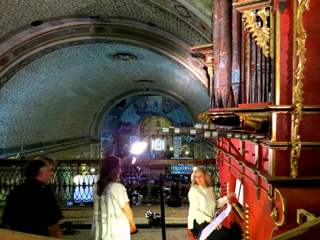 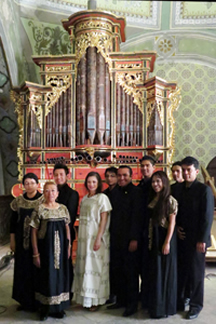
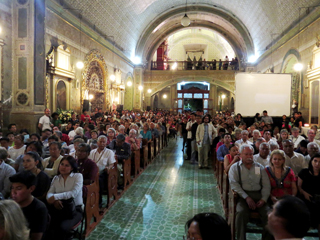
Approximately 1000 people attended, 500 people in the church and another 500 outside in the atrium hearing the mass and the music over a loudspeaker. We have been told that this is not a typical turnout for an organ concert in most countries! It was thrilling to hear the organ brought back to life, after so many years of silence and months of careful preparation.. One expert characterized its sound as “vocal” and was amazed how perfectly it blended with Lourdes’s pure soprano voice. Rafael led the enthusiastic singing of the mass with the organ and Lourdes sang several solos.
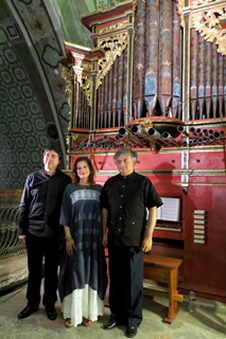
This was followed by the exciting reinaugural concert, the Seventh Concert of the Festival (Lourdes Ambriz, Rafael Cárdenas and Roberto Fresco) which highlighted all the registrations of the organ (program). The organ looked stunning and the community was so proud of this previously unrecognized aspect of their local culture.
February 24 (Monday)
For the third time we included a visit to the Tlaxiaco organ and points in between. This trip is not scheduled regularly, because its three-hour distance from Oaxaca City requires an overnight stay.
This year for the first time we visited the Mixtec community of Santiago Ixtaltepec which is farther away than any others we have included in past festivals, but the dirt road was in good condition and the scenery spectacular.
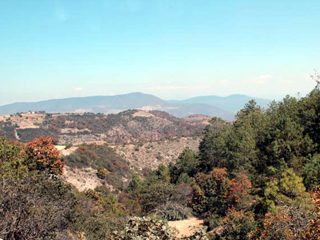
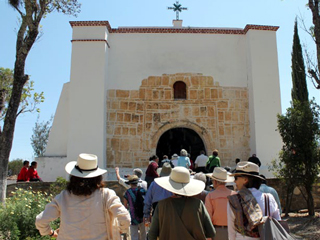
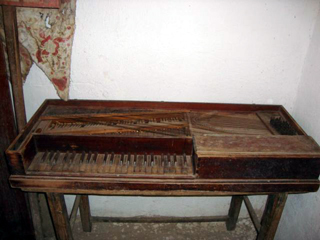
We included this village to celebrate the inauguration of their museum of musical instruments and colonial art in a small room next to the sacristy. An early 19th century fortepiano sits on a table and was presumably used as a practice instrument.
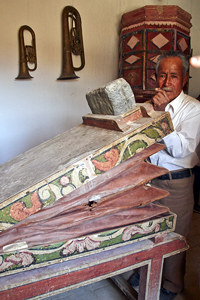
There is also a variety of 19th century band instruments on display. The community hopes that more people will come to visit their museum, and the IOHIO will promote it for anyone willing to make the trip.
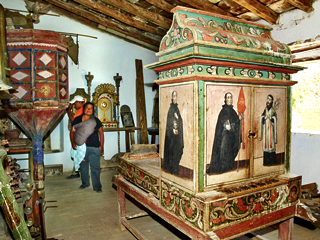
The 2´ table organ is the only one of its category in Oaxaca which still has its pipes, although not all of them appear to be original. The keyboard is in excellent condition and the table and bellows are decorated to match the organ. Interestingly enough, the figures depicted on the sides and doors of the organ appear to be Jesuit rather than Dominican, and the church itself has a Franciscan look. We wonder if the organ could have been purchased from another community, since we are discovering that organs were moved around more often than previously imagined.
The community of San Mateo Yucucuí sits on a promontory overlooking the Yanhuitlán Valley. The organ (1743) was never painted or gilded, which would have been typical of the period, probably because the parish ran out of money. But it is richly carved and still has its original keyboard. As mentioned above, its case closely resembles the sumptuously decorated yet empty organ case in Teotongo. It’s too bad that these two organs couldn’t somehow be combined into one! It is said that when this 8´ organ was played, it could be heard for miles around. The floor of the high balcony on which the organ sits is much deteriorated, but the custodian had laid down some planks so that the more daring of the participants could get a closer look.
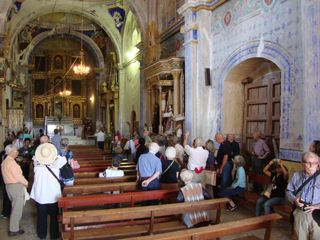
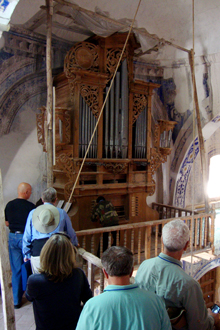
Our next stop was at the 16th century Dominican architectural complex - church, ex-convent and the famous open chapel - of San Pedro y San Pablo Teposcolula. The 8´ organ has a similar profile to that of Yanhuitlan but was painted a cream color rather than polychromed, probably because of lack of funds at the time of the construction. We refer to this organ as the King Midas organ now, because in 2010 a well-connected architect took the liberty of gilding at great cost all the carved pipeshades and moldings, even though it had only been minimally gilded historically and in fact the organ’s manufacture is not of the highest quality. Unfortunately one of the loveliest features of this organ—its delicate carving which before looked almost like lace—now has a hard look and the shine of the gold obscures the fine work of the carving. So, besides accumulated filth from negligence, the intrusion of animals and the ongoing risks of earthquakes or fires, we now have to be on guard against the whimsical decisions of misguided “experts”.
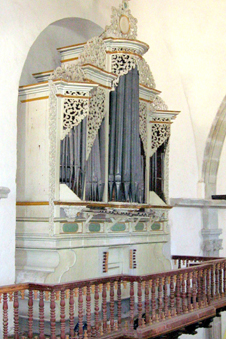 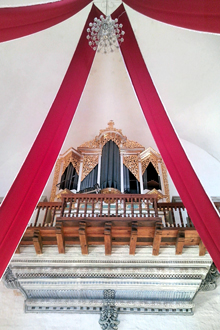
After lunch in Teposcolula, we drove up into the pine forest to Santa María Tlaxiaco for the Eighth Concert of the Festival. José Francisco Álvarez, organ, and Vladislav Badiarov, baroque violin, concluded the musical aspect of the festival with an elegant program featuring both solo and ensemble pieces.
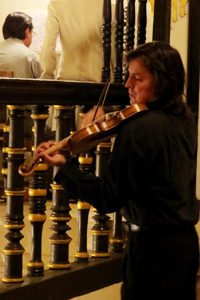 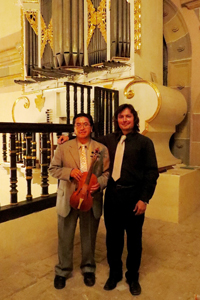 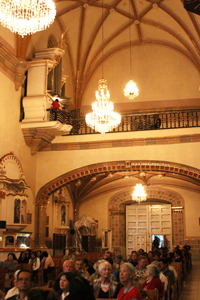
This monumental 8´ organ, dating from around 1800, offers a broad palette of sonorous possibilities which were enhanced by the excellent acoustics in the church. All the altarpieces and the organ are synchronized in neo-classic design and painted white, gold and red, creating an unusual visual coherence. The imposing, outwardly austere church, one of Oaxaca’s oldest, was the Dominican outpost for this strategic area of the high sierra in the 16th century.
February 25 (Tuesday)
After breakfast, the group of die-hard organists spent an enjoyable hour playing the Tlaxiaco organ. The others chose to visit the late pre-classic and classic (400 BC – 800 AD) Mixtec archeological site and the community museum of San Martín Huamelulpan with a guided tour provided by Marcus Winter of the INAH.
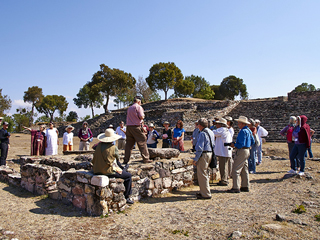 
From there we went to the nearby village of San Pedro Mártir Yucuxaco. The table organ here (1740) is complete and in excellent condition, even though its bellows no longer exist. It closely resembles the organ in Zautla, though without the painted decoration, the carved pipeshades include faces in profile, and the keyboard is exquisite.
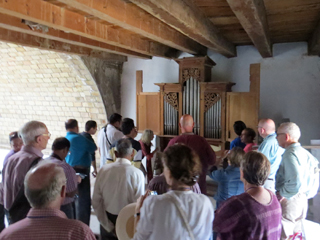
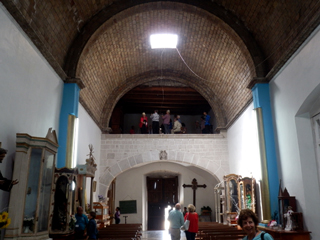
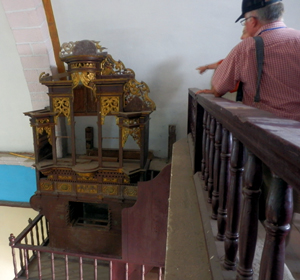 Our Mixtec tour continued with a visit to the church and organ of Santiago Tejupan. The lovely polychromed organ case (1776) is the last extant Oaxacan instrument to exhibit religious imagery. The name of the donor, cost of the organ and date of construction appear inscribed on decorative medallions on the façade. A complete reconstruction of this organ would not make sense, however, since the population has been drastically reduced over the past years, but we hope that the authorities agree to have the case cleaned and restored in order to appreciate the unique portraits. Our Mixtec tour continued with a visit to the church and organ of Santiago Tejupan. The lovely polychromed organ case (1776) is the last extant Oaxacan instrument to exhibit religious imagery. The name of the donor, cost of the organ and date of construction appear inscribed on decorative medallions on the façade. A complete reconstruction of this organ would not make sense, however, since the population has been drastically reduced over the past years, but we hope that the authorities agree to have the case cleaned and restored in order to appreciate the unique portraits.
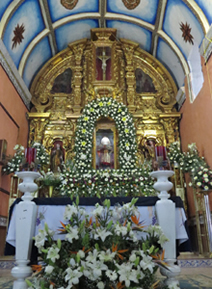
The splendid altarpieces span from the 17th to the 19th
century and highlight the stylistic changes over time.
Our final church and organ visit was in Santa María Tiltepec, for some the crowning visual experience of the field trips. Located in the dominican sphere of Yanhuitlan and built atop a prehispanic temple, this 16th century church has long been appreciated by art historians for its richly carved, asymmetrical façade and carved stone interior arches. The unrestored organ, situated on a side balcony, is one of Oaxaca´s oldest (1703) and is unique in its technical design, whimsical decoration and finely carved keyboard.
 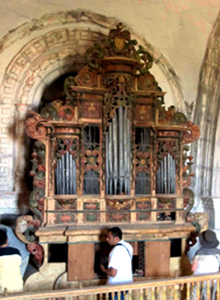
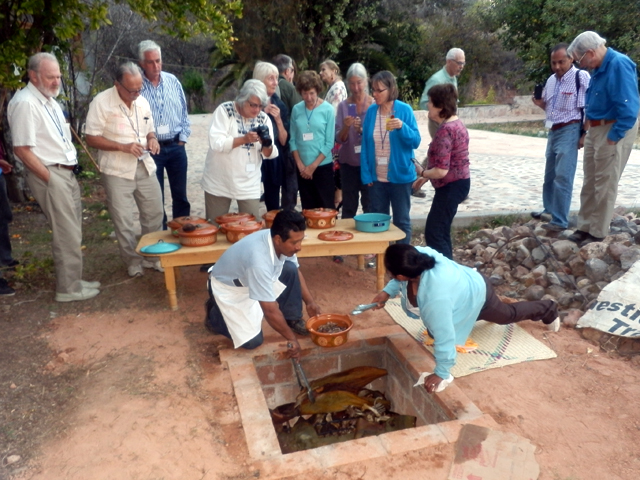
We then walked down the hill and across the river to the home of the Cruz García family for our farewell dinner. We feasted on barbacoa de borrego, lamb barbecued Oaxacan style, cooked in the ground over hot rocks and covered with maguey leaves.
Mezcal from San Bartolo Yautepec flowed freely, and everyone had one last chance to enjoy the festival company and dance to music from a local guitar ensemble before returning to Oaxaca.
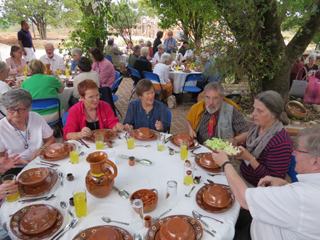 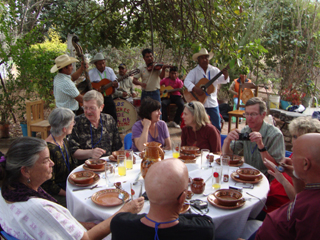
February 26 (Wednesday)
Even after the closing ceremony in Tiltepec, this Festival just would not stop! Around 40 people chose to make the trek up to the recently opened late classic (500 – 800 AD) archeological site of Santa María Atzompa, part of greater Monte Alban, guided by Dr. Marcus Winter (INAH).
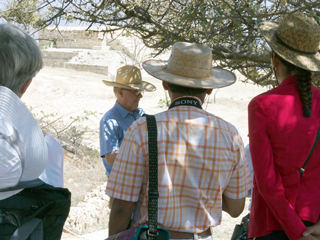
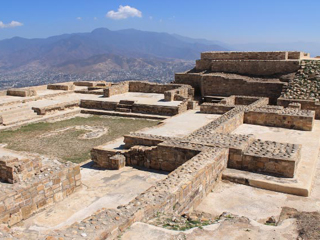
In conclusion, our festivals create an atmosphere of joy and celebration around the organs and have proved to be without a doubt the best way to promote and, as a consequence, preserve the organs. We are continually amazed when people ask when the next concert or festival will take place, as we look back on all those years when hardly anyone knew or cared about the organs. And what a wonderful group of participants this year! Your support and enthusiasm still energize us as we face this year’s many challenges.

Please see Richard Perry´s blogspot http://colonialmexico.blogspot.com/
for detailed information and excellent photos of the churches visited during the Festival.
The IOHIO is grateful for the support of the following institutions:
CONACULTA INAH
Arquidiócesis de Antequera Oaxaca
Universidad de Valladolid, España
Biblioteca Francisco de Burgoa
Museo de Filatelia de Oaxaca (MUFI)
Caminos y Puentes Federales (CAPUFE)
We are also grateful for the support of the following Oaxacan businesses:
Hostal de la Noría
Hotel Parador San Agustín
Hotel de la Parra
Color Digital
Restored organs presented in the concerts during the Festival and unrestored organs we visited on the field trips.

Cathedral, Tamazulapan, Tlacolula, Soledad,
Zautla, Yanhuitlán, Tlaxiaco, Tlachochahuaya
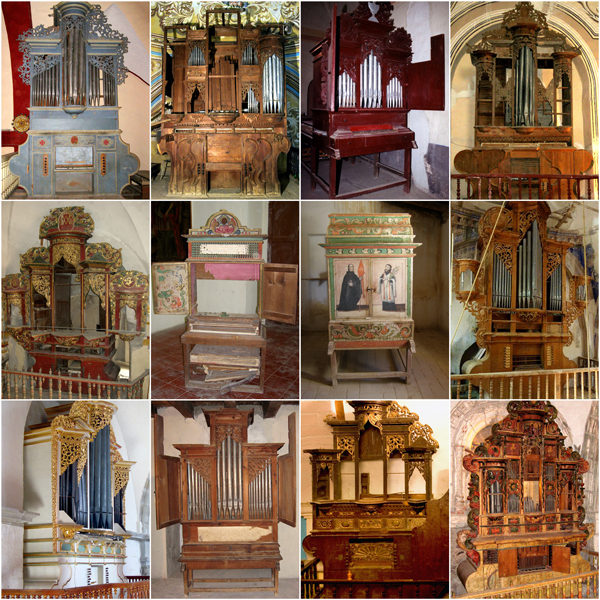
Jalatlaco, Tlalixtac, Huayapam, Tamazulapan (G),
Teotongo, Tlacolula (P), Ixtaltepec, Yucucuí,
Teposcolula, Yucuxaco, Tejupan, Tiltepec,
|

